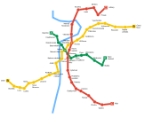
Prague Metro
Encyclopedia

Rapid transit
A rapid transit, underground, subway, elevated railway, metro or metropolitan railway system is an electric passenger railway in an urban area with a high capacity and frequency, and grade separation from other traffic. Rapid transit systems are typically located either in underground tunnels or on...
network in Prague
Prague
Prague is the capital and largest city of the Czech Republic. Situated in the north-west of the country on the Vltava river, the city is home to about 1.3 million people, while its metropolitan area is estimated to have a population of over 2.3 million...
, Czech Republic. It is the fastest means of transportation around the city and serves about one and a half million passengers a day, which makes it the seventh busiest metro system in Europe and the most-used in the world on a per capita basis.
Basic information
The Prague MetroRapid transit
A rapid transit, underground, subway, elevated railway, metro or metropolitan railway system is an electric passenger railway in an urban area with a high capacity and frequency, and grade separation from other traffic. Rapid transit systems are typically located either in underground tunnels or on...
comprises three lines, each of which is represented by its own colour on the maps and signs: Line A (green), Line B (yellow) and Line C (red). There are 57 stations
Metro station
A metro station or subway station is a railway station for a rapid transit system, often known by names such as "metro", "underground" and "subway". It is often underground or elevated. At crossings of metro lines, they are multi-level....
in total (three of which are transfer stations) connected by nearly 60 kilometres of mostly underground railways. The metro service operates between 4-5 am till midnight from Sunday till Thursday (on Friday and Saturday the last trains journey start at 1am), with about two- to three-minute intervals between trains during rush hour
Rush hour
A rush hour or peak hour is a part of the day during which traffic congestion on roads and crowding on public transport is at its highest. Normally, this happens twice a day—once in the morning and once in the evening, the times during when the most people commute...
s. Over 500 million passengers use the Prague Metro every year.
The metro is run by the Prague Public Transit Company Co. Inc. (in Czech officially Dopravní podnik hlavního města Prahy a.s.) which manages all means of public transport around the city (the metro, tramways
Prague Tram System
The Prague tram system is the largest tram system in the Czech Republic, consisting of 140 kilometres of track, over 900 tram cars, and 33 lines with a total route length of 540 km. It is operated by Dopravní podnik hlavního města Prahy a.s., a company owned by the City of Prague. The system...
, buses, the funicular
Petrín funicular
The Petřín funicular is a funicular railway in the Czech capital city of Prague. It links the Malá Strana district with the top of Petřín hill. The funicular has three stops: Újezd , Nebozízek and Petřín...
to Petřín Hill and the chairlift inside Prague Zoo
Prague Zoo
Prague Zoo is a zoo in Prague, Czech Republic. It was opened in 1931 with the goal to "advance the study of zoology, protect wildlife, and educate the public" in the district of Troja in the north of Prague. The zoo occupies 45 hectares and houses about 4,400 animals that represent 670 species...
). Since 1993, this system has been connected to commuter trains
Esko Prague
Esko Prague is a commuter rail system in Prague, Czech Republic. It has been in operation under its current name since December 9, 2007. Esko is part of the Prague Integrated Transport system serving the city of Prague and the surrounding areas of the Central Bohemian Region...
and buses and also to "park-and-ride" parking lots. Together they form a public transportation network reaching further from the city called Prague Integrated Transport (Pražská integrovaná doprava—PID). Whilst the large system is zonally priced, the metro is fully inside the central zone.
Many Prague Metro stations are quite large, with several entrances spaced relatively far apart. This can often lead to confusion for tourists, especially at the central hubs such as Můstek or Muzeum: it is not enough to merely get off at the right station; one must also choose the right way out to the surface, otherwise one can easily find oneself five or ten minutes' walking distance from the required destination. However, in general the stations are well signposted even for those unfamiliar with local language.
Layout and stations
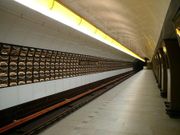
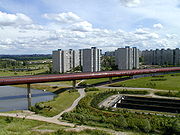
The Prague Metro system is laid out as a triangle, with all three lines meeting in the center of the city at three interchange station
Interchange station
An interchange station or a transfer station is a train station for more than one railway route in a public transport system, and allows passengers to change from one route to another. Transfer may occur within the same mode, or between rail modes, or to buses...
s. Each interchange station has two halls, one hall for each line. The depth of the stations (and the connecting lines) varies considerably. The deepest station is Náměstí Míru, located 52 meters under the ground. Parts of the tracks in the city center were mostly bored using the tunneling shield
Tunnelling shield
A tunnelling shield is a protective structure used in the excavation of tunnels through soil that is too soft or fluid to remain stable during the time it takes to line the tunnel with a support structure of concrete, cast iron or steel...
. Outer parts were dug by the cut-and-cover method and the stations are only a few meters under the surface. The B line partly runs in a glassed-in tunnel above the ground.
Most stations have a single platform
Railway platform
A railway platform is a section of pathway, alongside rail tracks at a train station, metro station or tram stop, at which passengers may board or alight from trains or trams. Almost all stations for rail transport have some form of platforms, with larger stations having multiple platforms...
in the center of the station hall (tunnel) serving both directions. The sub-surface stations have a straight ceiling sometimes supported by columns. The deep-level stations are larger tunnels with the track tunnels on each side. The walls of many stations are decorated using colored aluminium panels, each station having its own color.
| # | Name | Opened | Length | Stations |
|---|---|---|---|---|
| A | Line A Line A (Prague Metro) Line A is a line of the Prague Metro, serving the Czech Republic capital. Chronologically the second line in the system, it was first opened in 1978 and has expanded mostly during the 1980s... (Linka A) |
1978 | 11.0 km | 13 |
| B | Line B Line B (Prague Metro) Line B is a line on Prague Metro. Chronologically the third to open, it was first opened in 1985 and continued to expand in the 1990s. Currently it is the longest line in the network with 24 stations and of track.-History:-External links:... (Linka B) |
1985 | 25.6 km | 24 |
| C | Line C Line C (Prague Metro) Line C is a line on the Prague Metro. It crosses the right-bank half of the city center in the north-south directions and turns to the east at both ends of the line. It is the system's oldest and most used line, being opened in 1974 and transporting roughly 26,900 persons per hour in the peak. The... (Linka C) |
1974 | 22.7 km | 20 |
| Total: | 59.3 km | 57 (transfer stations counted as two; see above) |
Tickets
The Prague Metro is an open ticket system. Passengers must buy and validate a ticket before entering the metro platform. There are uniformed and plain clothes ticket inspectors who have the right to check the validity of the ticket at any time within the compulsory ticket area.The tickets are the same for all means of transport in Prague (excluding commuter trains for single tickets). The basic single tickets cost 32 CZK
Czech koruna
The Czech koruna or Czech crown has been the currency of the Czech Republic since 8 February 1993 when, together with its Slovak counterpart, it replaced the Czechoslovak koruna at par....
(as of 1 July 2011) for a 90 minute ride or 24 CZK for a 30 minute ride. Since December 2007 SMS purchase for the basic single transfer tickets and day tickets is possible.
Short-term tourist passes are available for periods of 24 hours (110 CZK), 3 days (310 CZK) and 5 days (500 CZK).
Longer-term season tickets can be bought on the smart ticketing system Opencard, for periods of one month (550 CZK), three months (1480 CZK), five months (2450 CZK) or the annual pass (4750 CZK).
History
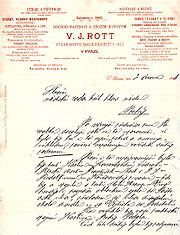
Ladislav Rott
Ladislav Rott is one of the sons and eight children of Vincenc Josef Rott, founder of the V. J. Rott company in Prague, Malé náměstí ....
in 1898. He encouraged the city council to take the advantage of the fact that parts of the central city were already being dug up for sewer work. Rott wanted them to start digging tunnels for the railway at the same time. However, the plan was denied by the city authorities. Another proposal in 1926, by Bohumil Belada and Vladimír List
Vladimír List
Vladimír List was a Czech electrical engineer, scientist and university teacher active in area of technical standardization....
, was the first to use the term "Metro", and though it was not accepted either, it served as an impulse for moving towards a real solution of the rapidly developing transport in Prague. In the 1930s and 1940s, intensive projection and planning works were being held, taking into account two possible solutions: an underground tramway (regular rolling stock going under ground in the city center, nowadays described as a "pre-metro") and a "true" metro having its own independent system of railways. After World War II, all work was stopped due to the poor economic situation of the country, although the three lines, A, B and C, had been almost fully designed.
In the early 1960s the concept of the sub-surface tramway was finally accepted and on 9 August 1967 the actual building of the first station (Hlavní nádraží) started. However, at the same year, a substantial change in the concept came, as the government, under the influence of Soviet advisers, decided to build a "true" metro system instead of an underground tramway. Thus, during the first years, the construction continued while the whole project was conceptually transformed. The regular service of the first section of line C began operating on 9 May 1974 between Sokolovská (now Florenc
Florenc
Florenc is a Prague Metro station providing the interchange between Lines B and C. It serves the city's central bus station.The station was formerly known as Sokolovská....
) and Kačerov
Kacerov
Kačerov is a Prague Metro station on Line C....
stations. Building continued quite rapidly after that. In 1978 the first section of line A was opened and, finally, line B opened in 1985, thus forming the triangle with three crossing points. Since then, the tracks have been extended further from the center. Line B was extended from Nové Butovice to Zličín
Zlicín (Prague metro)
Zličín is a Prague Metro station and terminus of Line B. Zličín metro station gives direct pedestrian access to the 2004 constructed Metropolis shopping mall, and has zero-fare bus links to the nearby Globus, Tesco and Ikea hypermarkets....
in 1994 and from Českomoravská
Ceskomoravská
Českomoravská is a Prague Metro station on Line B opened in 1990. It is located under Drahobejlova street in Vysočany. For some time Českomoravská was a terminal station until the extension of Line B to Černý Most in 1998....
to Černý Most
Cerný most
Černý most is a housing estate in Prague and also a Prague Metro station and terminus of Line B....
in 1998. The Kolbenova
Kolbenova
Kolbenova is a Prague Metro station on Line B.- External links :* http://www.angrenost.cz/metro/b/ko.php Gallery * on...
and Hloubětín
Hloubetín (Prague metro)
Hloubětín is a Prague Metro station on Line B.- External links :* http://www.angrenost.cz/metro/b/hl.php Gallery...
stations were opened in 2001.
On 22 February 1990, 11 stations with names reflecting communist ideology were changed to be politically neutral. Leninova station, which contained a giant bust of Lenin before the Velvet Revolution
Velvet Revolution
The Velvet Revolution or Gentle Revolution was a non-violent revolution in Czechoslovakia that took place from November 17 – December 29, 1989...
, was renamed Dejvická
Dejvická
Dejvická is a Prague Metro station and terminus of Line A. It lies at the western end of the main boulevard Evropská Třída, and is served by buses which run to Ruzyně International Airport. The station was opened on 12 August 1978 as a part of the line. It was formerly known as Leninova after...
after a nearby street and surrounding neighbourhood.
In the meantime, the old Russian trains are slowly wearing out and are being refurbished or replaced. The refurbished trains are projected to serve for another 15 years. The renewal of the rolling stock should be completed by 2007.

Bohemia
Bohemia is a historical region in central Europe, occupying the western two-thirds of the traditional Czech Lands. It is located in the contemporary Czech Republic with its capital in Prague...
and other areas in Central Europe
Central Europe
Central Europe or alternatively Middle Europe is a region of the European continent lying between the variously defined areas of Eastern and Western Europe...
(see 2002 European flood). 19 stations were flooded, causing a partial collapse of the transport system in Prague; the damage to the metro has been estimated at approximately 7 billion CZK
Czech koruna
The Czech koruna or Czech crown has been the currency of the Czech Republic since 8 February 1993 when, together with its Slovak counterpart, it replaced the Czechoslovak koruna at par....
(over US$200 million). The affected sections of the metro stayed out of service for several months; the last station (Křižíkova
Križíkova
Křižíkova is a Prague Metro station on Line B in the Prague district of Karlín. It was severely damaged in the 2002 floods, but was re-opened after being restored the following year....
, located in the most-damaged area - Karlín) reopened in March 2003. Small gold plates have been placed at some stations to show the highest water level of the flood.
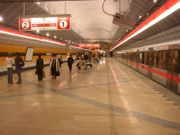
Kobylisy
Kobylisy is a Prague Metro station on Line C.- External links :* http://www.angrenost.cz/metro/c/kb.php Gallery and information...
and Ládví. Notable is the way that new tunnels were built under the Vltava
Vltava
The Vltava is the longest river in the Czech Republic, running north from its source in Šumava through Český Krumlov, České Budějovice, and Prague, merging with the Elbe at Mělník...
river. A unique "ejecting-tunnels" technology was chosen for this. First, a trench was excavated in the riverbed and the concrete tunnels constructed in dry docks on the riverbank. Then the docks were flooded, and the floating tunnels were moved as a rigid complex to their final position, sunk, anchored and covered.
Line A was recently extended farther to the east. On 26 May 2006, a new terminus, Depo Hostivař
Depo Hostivar
Depo Hostivař is a Prague Metro station and terminus of Line A. The station was constructed in the building of an existing metro depot and was opened in 2006....
, opened. The station was constructed within the buildings of an existing railway depot. The extension is the first segment of the system that has been built above ground and not through a tunnel.
Line C has been recently extended further to the northeast to connect the city center to the large housing blocks
Panelák
is a colloquial term in Czech and Slovak for a panel building constructed of pre-fabricated, pre-stressed concrete, such as those extant in Czech Republic and elsewhere in the former Soviet bloc...
in Prosek. Three stations (Střížkov, Prosek and Letňany) opened on 8 May 2008.
Rolling stock

- M1, serving on line C since 1998, completely replaced older cars on line C in 2003. The metro owns 48 units. These units were manufactured in Prague by consortiumConsortiumA consortium is an association of two or more individuals, companies, organizations or governments with the objective of participating in a common activity or pooling their resources for achieving a common goal....
consisting of ČKD Praha, ADtranzAdtranzABB Daimler-Benz Transportation , commonly known under its brand Adtranz, was a multi-national rail transport equipment manufacturer with facilities concentrated in Europe and the USA....
and SiemensSiemensSiemens may refer toSiemens, a German family name carried by generations of telecommunications industrialists, including:* Werner von Siemens , inventor, founder of Siemens AG...
(during the contract Siemens acquired ČKD Praha). This unit was also adapted for use in Venezuela on the Maracaibo MetroMaracaibo MetroThe Maracaibo Metro, also known as Metro del Sol Amado, is a six-station metro system in Maracaibo, Venezuela. Service between La Vanega and El Varillal opened to the public on November 25, 2006, with all stations on the line opened on June 9, 2009.The metro encompasses the suburbs of Maracaibo...
. - 81-71M, modernized variant of the old Soviet 81-7181-717/71481-717/714 is a metro car designed for rapid transit systems of the Soviet Union in the middle 1970s....
trains serving on the line A and on line B. First modernization was completed in 1996 and they are still continuing since in Škoda TransportationŠkoda WorksŠkoda Works was the largest industrial enterprise in Austro-Hungary and later in Czechoslovakia, one of its successor states. It was also one of the largest industrial conglomerates in Europe in the 20th century...
. Similar reconstructions were also made in the Tbilisi metroTbilisi MetroThe Tbilisi Metro is a rapid transit Metro system in Tbilisi, the capital of Georgia. Opened in 1966 it became the fourth Metro system in the former Soviet Union. Like most ex-Soviet Metros, most of the stations are very deep and vividly decorated....
.
Previously in service:
- 81-7181-717/71481-717/714 is a metro car designed for rapid transit systems of the Soviet Union in the middle 1970s....
, old Soviet trains manufactured by Metrovagonmash serving only on line B, being gradually phased out and replaced by the modernized versions. Their service ended on 2 July 2009. Note that the original type designation discerned between cab (81-717) and cabless (81-714) cars, whlie Czech did not, referring to a whole trainset consisting of both 717 and 714 type cars. - EčsECS-In technology:*Amazon E-Commerce Service, former name of the Amazon Associates Web Service, now known as Amazon Product Advertising API*eComStation, a computer operating system...
, Soviet trains manufactured by Metrovagonmash, that ran on line C, in service from 1974-1997.
Features
"MůstekMustek
Můstek is a Prague Metro station that serves as an interchange point between lines A and B...
" means "little bridge" and refers to the area around the Můstek station. The origin of the area's name was not known until remains of a medieval bridge were discovered during construction of the station. The remains were incorporated into the station and can be seen near the northwestern exit of the station.
The escalator at Náměstí Míru
Námestí Míru
Náměstí Míru is a Prague Metro station on Line A. It is located in Vinohrady district under Korunní Street and has one exit through an escalator tunnel with a sub-surface vestibule under the plaza of the same name...
station in Vinohrady
Vinohrady
Vinohrady is a cadastral district in Prague. It is so named because the area was once covered in vineyards dating from the 14th century...
is about 100 metres long and, according to its builder, is the longest escalator in Europe. It takes about two and a half minutes to ascend or descend the escalator if you stand still.
Between I. P. Pavlova
I. P. Pavlova
I. P. Pavlova is a Prague Metro station on Line C. It was opened on 9 May 1974. Above the station is I. P. Pavlov Square , which is named after Russian physiologist Ivan Petrovich Pavlov. Both the station and the square are shortened by locals to Pavlák or Ípák...
and Vyšehrad
Vyšehrad (Prague metro)
Vyšehrad is a Prague Metro station on Line C.The station was opened on 9 May 1974. The station serves Vyšehrad and was formerly known as Gottwaldova....
stations, Line C runs inside the box structure of the Nusle Bridge
Nusle Bridge
Nusle Bridge is a concrete viaduct in Prague, passing over the district of Nusle in Prague 4. It spans the Nusle Valley and connects the Pankrác district and south-eastern parts of the city, as well as the D1 motorway with the central part of the city. Below the six-lane highway on the surface,...
over a steep valley.
Anděl station was known as Moskevská (Moscow Station) until 1990. It opened on the same day in 1985 as the Prazhskaya (Prague) station on the Moscow Metro
Moscow Metro
The Moscow Metro is a rapid transit system serving Moscow and the neighbouring town of Krasnogorsk. Opened in 1935 with one line and 13 stations, it was the first underground railway system in the Soviet Union. As of 2011, the Moscow Metro has 182 stations and its route length is . The system is...
. It contains several pieces of propaganda
Propaganda
Propaganda is a form of communication that is aimed at influencing the attitude of a community toward some cause or position so as to benefit oneself or one's group....
art promoting Soviet-Czechoslovak friendship. Anděl station, like the Smíchov train station, contains some of the best-preserved examples of Communist-era propaganda art remaining in Prague.
During the communist period rumors circulated that large "survival chambers" were being built for high officials of the government in the case of a nuclear attack. After the fall of communism such areas were shown indeed to exist, but not on the scale envisioned nor fitted out in luxury.
The future
There are further plans to build a completely new line, the D line (or blue line). Line D would connect the city centre to the southern parts of the city and according to the newest plans, the line would go from Náměstí RepublikyNámestí Republiky
Náměstí Republiky is a Prague Metro station on Line B in the Prague 1 district. Its two exits serve the Republic Square area and the Masaryk suburban railway terminal respectively....
(interchange with the B line) through Hlavní nádraží (the main train station, interchange with the C line) and the Nusle quarter down to the suburban neighbourhoods of Krč, Libuš and Písnice in the south. If the project goes well, the first sections of the line will commence operation around 2015.
The first phase of a CZK18.7 billion extension on the west end of the A line is currently under construction, from Dejvická station to Motol, which is forecast to open to the public in 2014. The second phase of this extension will see the line reach Ruzyně International Airport
Ruzyne International Airport
-Ruzyně today:Most flights depart Ruzyně Airport from the North Terminals . The South Terminals handle a few irregular flights, as well as VIP flights, special flights and small aircraft....
and is set to open by 2021. Before this, a railway connection to the airport will be opened.
An E line has also been proposed, but not much is known about it yet and no official plans were released.
Culture
The Prague Metro is used very much by locals, and the quote given by the PA system when the doors are closing, "Ukončete, prosím, výstup a nástup, dveře se zavírají" (Please finish boarding and exiting, the doors are closing) has become a symbol of Prague for some tourists, and is possibly the first clear Czech phrase many travelers hear.External links
- Official pages of Prague Public Transit Co. Inc. including maps, fare information, etc.
- DP-Praha Fares
- DP-Praha Fares
- Prague Metro – an interesting English website about the Prague Metro system with many photos of stations, map, history, rolling stock description, discussion etc.
- www.metroweb.cz – pages of Czech metrophiles with plenty of information and pictures (in Czech, with some information available in English)
- http://www.metroweb.cz/povoden/foto-metro.htm - Prague metro photo (after 2002 flood)
- http://www.revizorfoto.estranky.cz - Prague metro photo

